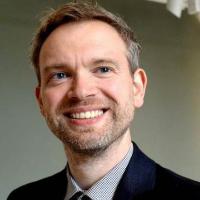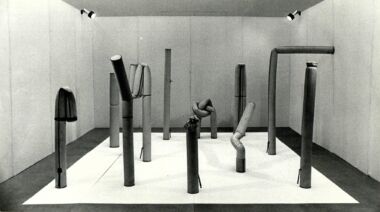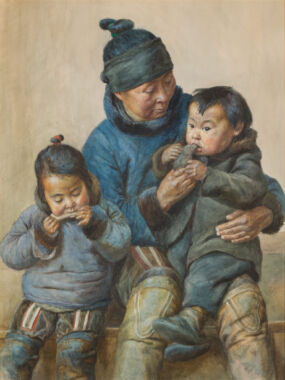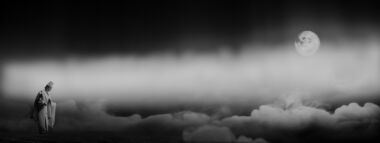Summary
Editor: Rasmus Kjærboe, Ribe Art Museum.
Article
Danish artist Kristian Zahrtmann taught hundreds of important artists from the Nordic countries, was a co-founder of Den frie Udstilling (The Free Exhibition) in Copenhagen and found success with his contemporary take on history painting as a genre. His paintings of the unfortunate princess Leonora Christina remain popular today and have shaped how several generations see the history of Denmark. But today it is his persistent and courageous work as a queer artist that makes Zahrtmann an important and pioneering figure in international art history.
Amidst his many genre pieces and history paintings, as well as colourful depictions from poor regions in Italy, Zahrtmann also painted forth his own queer universe. In picture after picture he offered his personal take on a world where men can be desired by other men, and where proud and strong women are lauded for opposing conventional standards of appearance, behaviour and action. Through hints and allusions, parody and humour – and at times even direct speech – Zahrtmann worked on creating a queer space for himself through his art.
Zahrtmann’s unique project took place at a time when homosexual practices were punishable and where deviations from the established norm made you the subject of medical diagnoses. He wielded – and potentially jeopardised – his significant prestige when, from around 1900, he began to exhibit erotic pictures of male nudes and works which actively and parodically undermined gender norms. These efforts have subsequently been forgotten, if not actively suppressed, but today we are able to reassess and excavate his endeavours, clearly seeing that with his personal courage and uncompromising artistry, Zahrtmann was a truly outstanding figure in Danish art history. Even when seen from an international perspective, he stands among the few who dared to paint queer works at an early stage and even found major success doing so.
This collection of research articles looks at the many queer aspects of Kristian Zahrtmann’s art and life. They position him as an important artist who did pioneering work on an international scale. One of the important obligations of art historical research is to continually interpret and process the art of the past so that it is relevant to the present, for example by linking it to contemporary concerns. As the four new articles and one re-issue presented here will show, Zahrtmann’s work is more relevant today than ever. His art represents a still-valid effort to expand a queer space of opportunity, adding greater nuance to our understanding of what it means to be and lead a queer life now and then. Relationships, worries and joys that we might have thought unique to our present day may turn out to be less ‘new’ than we thought.
In the introductory article, Rasmus Kjærboe considers Zahrtmann’s art in the light of queer theory, analysing how the artist seeks to create a ‘room of his own’ in a literal and metaphorical sense alike – a space for himself, his desire and his identity. Michael Hatt delves into the question of how Zahrtmann, in the midst of the greatest persecution of homosexuals in the history of Denmark, drew inspiration from Socrates and antiquity to paint his way to a homosexual ethics. Rikke Zinck Jensen explains Zahrtmann’s long-standing fascination with strong, tragic and ‘alternative’ women who defied established categories – in Zahrtmann’s art, gender is performative and played out as if on stage. Patrik Steorn considers the fascination with nude men, connecting it to a number of Nordic artists and changes in social conditions around the year 1900. In a re-issue with an added postscript of Morten Steen Hansen’s groundbreaking article from 1995, the painter and his history paintings are contextualised in relation to homosexuality and the challenge of norms: Zahrtmann sought to re-actualise and renew artistic tradition within its own framework, and as he grew older, this increasingly involved challenging established rules for sexuality, gender roles and behaviour.
This marks the first time that the online journal Perspective publishes a themed collection of articles. Research of international relevance should be available internationally. For this very reason, we are pleased to be based on a strong Open Access platform. We are also grateful to the editors at the National Gallery of Denmark.
The present collection of articles is published in connection with the exhibition Kristian Zahrtmann. Queer, Art and Passion on display at Ribe Art Museum, Fuglsang Art Museum and The Hirschsprung Collection in 2019–20.
Thanks
We are grateful for the support provided by the Danish Ministry of Culture’s research fund, which has greatly aided the research and research workshops along the way. Thanks are also due to the many foundations that have supported the exhibition and the publication of this research: 15. Juni Fonden, Arne V. Schleschs Fond, Augustinus Fonden, Beckett-Fonden, Bestles Fond, Bikubenfonden, Dronning Margrethe og Prins Henriks Fond, Knud Højgaards Fond, Lemvigh-Müller Fonden and William Demant Fonden (formerly Oticon Fonden).
We are grateful to the museums, libraries and archives who have contributed visual materials, including Bruun Rasmussen Auctioneers, which have helped find the owners of several works and made photographs available to us for free. Finally, a big thank you goes out to the authors of the individual articles: you have spent many hours and much effort on restore an old, queer artist to his rightful position of relevance today.
Rasmus Kjærboe, Ribe Art Museum and Aarhus University
Dagmar Warming, Ribe Art Museum



